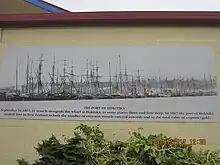City of Dunedin (ship)
The City of Dunedin was a 327-ton side wheel paddle steamer wrecked in Cook Strait near Cape Terawhiti on 20 May 1865 while sailing from Wellington to Hokitika via Nelson with the loss of all on board.[3] Captain James Parker Boyd commanded her.[4]
| History | |
|---|---|
| Name | PSS City of Dunedin |
| Owner | John Jones and John Cargill |
| Port of registry | |
| Route | Port Chalmers, Dunedin to Hokitika |
| Builder | Denny & Co, Dumbarton |
| Yard number | 28 |
| Completed | 16 June 1863 |
| Fate | Wrecked 20 May 1865 |
| General characteristics [1][2] | |
| Type | Clipper |
| Tonnage | 327 gross register tons (GRT) |
| Length | 167 ft (51 m) |
| Beam | 22 ft (6.7 m) |
| Depth | 17 ft (5.2 m) |
| Installed power | 2 x 50hp Denny and Co diagonal boilers |
| Propulsion | paddle |
| Sail plan | schooner rigged |
| Speed | 10 knots |
Construction
The City of Dunedin was an iron paddle steamer built in Glasgow by Archibald Denny of Dumbarton. She was fitted with 100 hp Denny and Co steam engines. Miss Margaret Robson of Glasgow named her.
She had been built specifically for the coastal trade around New Zealand. She was owned by Jones and Co of Otago.[5][6]
She was described as not being elegant in appearance, but .. handsome proportions, and thorough adaption for the trade in which she is to be employed ... She had a full length spar deck, a new type of windlass to aid mooring and unmooring the vessel. The main deck was 7 feet below the spar deck. She had fore and aft holds, separated by the engine room. Her dimensions were 167 feet long by 23 feet beam. Her fully laden draught was 6.5 feet and her depth 15 feet. Her normal speed was 10 knots. There were 56 berths for passengers.
John Jones who owned a 54/64ths share in the boat had not insured his share. The remaining 10/64th owners had insured their shares.[7]
Maiden voyage
Her maiden voyage from Glasgow to Dunedin under Captain McFarlane took 87 days. She left Glasgow on 9 July and arrived in Dunedin in November.[8] The ships engineers for the journey were inexperienced and did not maintain the engines properly. On reaching the Bay of Biscay the ship no longer ran on steam and had to revert to sail. She put into Madeira to repair the engines and to the Cape Verde Islands to obtain coal. On reaching the equator the ship again reverted to sail until it reached the Solanders.[9] The journey was without incident until 600 miles from the Cape of Good Hope where she ran into strong winds.[10] After arriving at Dunedin she was sent over to Melbourne to be docked as there was no dock at Dunedin.
Coastal trade

Her first journey was an excursion for guests of the owners from Port Chalmers to Otago Heads on 5 December 1863. Her first commercial voyage was the following week, sailing from Port Chalmers at 1pm on Wednesday, 9 December. She stopped at Waikouaiti, Moeraki, Oamaru, Timaru, and Akaroa before arriving at Lyttleton on 12 December.[11] She left Lyttelton on 16 December and arrived back at Port Chalmers on the 20th. The proposal was for this to be a prelude to a weekly service between these ports in conjunction with the Geelong.[12]
By May 1864 she had sailed to Wellington and was regularly sailing to Havelock and Picton.[13] In early 1865 she began calling at Wellington and Nelson.[14][15] With the West Coast gold rush, Hokitika was added to her ports of call by April.[16]
Disappearance
Sightings

The City of Dunedin sailed from Wellington at about 4pm on Saturday 20 May 1865. She was sighted later that afternoon by a 15-year-old girl, Miss McMenamen[17] while she was out horse riding at Cape Terawhiti, close in shore among the rocks. She thought the steamer had lost its steering as it was sailing in circles. The crew appeared to be confused, raising and lowering the sails. On returning home she asked her mother to come and look, but as her mother was busy she did not go. The wind on that day was reported as a fresh south-easterly.[18] Later accounts refer to there having been a storm on the 20th and 21st.[19]
Search
When the City of Dunedin failed to arrive in Nelson she was initially thought of as being either delayed or having sailed straight to Hokitika. As time went on and debris was found along the Wellington coast, she was considered to have hit one of the rocks near the Cape and sunk.[20]
The gunboat Sandfly under Captain Fox carried out a search of the shores on both sides of the strait.[21]
A search on foot of the coast from Lyall Bay to Ohariu Bay was carried out by J W Rayer to ascertain the ships fate. Various pieces of the ship and its contents were found strewn along the coast. The majority of the relics of the wreck were found between the Pilot Station and Sinclair Head.
Estimates of the actual number of passengers ranged from 250 to 600 in some papers published 20 to 40 years after the event. She did have capacity to carry these kinds of numbers as on her initial excursion to Otago Heads in 1863 she had about 500 on board.[22] The point against these claimed numbers is that the newspapers at the time the ship went missing only referred to 50 to 60 people on board.[23] In addition, despite searches of the coastline where she was supposed to have foundered, no bodies were found.
Fund for orphans and widows
Fund raising was undertaken at various parts of the country to assist those who had lost family members.[24]
References
- "Steamer 'City of Dunedin'- Mysterious Sinking Cook Strait, New Zealand May 20, 1865". November 2003. Retrieved 13 April 2015.
- "PSS City of Dunedin (+1865)". WreakSite.eu. Retrieved 13 April 2015.
- Supposed loss of the SS City of Dunedin and of all hands, Otago Witness, Volume 03, Issue 705, 3 June 1865, Page 11
- Arrived, Wellington Independent, Volume XIX, Issue 2199, 29 April 1865, Page 2
- The lost City of Dunedin, Daily Southern Cross, Volume XXI, Issue 2463, 12 June 1865, Page 4
- Reported loss of the P.S. City of Dunedin, North Otago Times, Volume IV, Issue 68, 8 June 1865, Page 3
- Untitled, Evening Post , Issue 107, 13 June 1865, Page 2
- Untitled, Otago Daily Times , Issue 605, 25 November 1863, Page 4
- The Steamer City of Dunedin, White Wings Vol I. Fifty Years Of Sail In The New Zealand Trade - 1850 TO 1900
- Shipping intelligence, Lyttelton Times, Volume XX, Issue 1164, 1 December 1863, Page 4
- From Dunedin to Lyttelton - on board the City of Dunedin, Lyttelton Times, Volume XX, Issue 1170, 15 December 1863, Page 5
- Shipping intelligence, Lyttelton Times, Volume XX, Issue 1173, 22 December 1863, Page 4
- Shipping intelligence - northern and southern mails, Lyttelton Times, Volume XXI, Issue 1243, 31 May 1864, Page 3
- Page 2 Advertisements Column 4, Wellington Independent, Volume XIX, Issue 2164, 7 February 1865, Page 2
- Testimonial to Captain Whitwell, Colonist, Volume VIII, Issue 766, 24 February 1865, Page 2
- Steam racing, Wellington Independent, Volume XIX, Issue 2199, 29 April 1865, Page 2
- "Loss of the City of Dunedin with all hands". Ministry for Culture and Heritage. 28 January 2015. Retrieved 2 April 2015.
- Wreck of the City of Dunedin, Nelson Examiner and New Zealand Chronicle, Volume XXIV, Issue 115, 23 September 1865, Page 3
- The lost City of Dunedin, Colonist, Volume VIII, Issue 793, 2 June 1865, Page 2
- Supposed loss of the City of Dunedin, Bruce Herald, Volume III, Issue 61, 8 June 1865, Page 5
- The City of Dunedin, Evening Post , Issue 103, 8 June 1865, Page 2
- Ancient wrecks, Marlborough Express, Volume XLIII, Issue 174, 21 July 1909, Page 2
- Supposed loss of the steamer City of Dunedin - Editorial, Evening Post , Issue 94, 29 May 1865, Page 2
- Latest telegrams, Press, Volume VII, Issue 826, 23 June 1865, Page 2